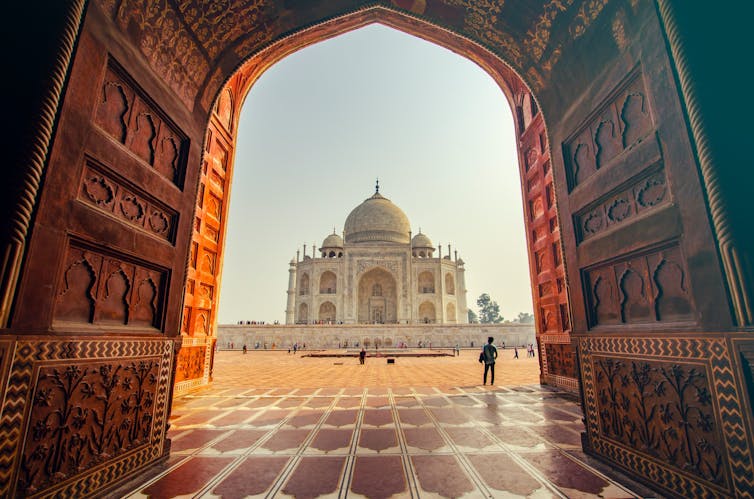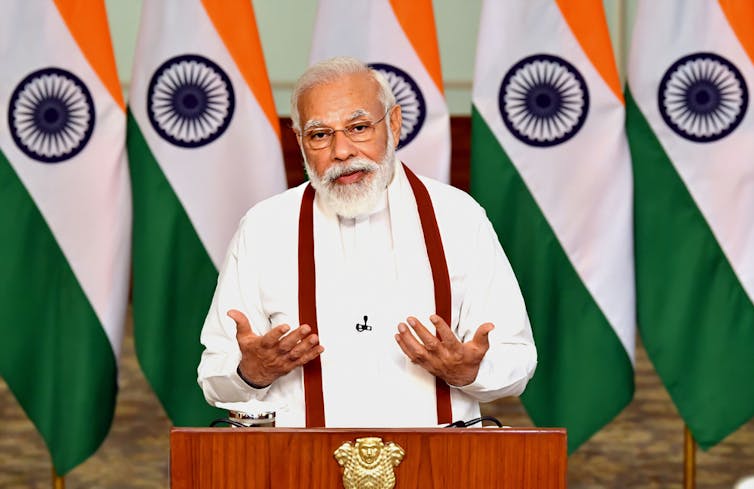
Sylwia Bartyzel, CC BY-SA
Sangeeta Khorana, Bournemouth University
At a time when so little international business is face to face because of the pandemic, the UK is flying ministers to India to lay the groundwork for a deal on free trade.
In a sign of the importance that the UK attaches to reaching what is being described as an “enhanced trade partnership” with India on the back of Brexit, the international trade secretary, Liz Truss, has been meeting Piyush Goyal, the Indian commerce and industry minister.
It is part of a British wide charm offensive with the subcontinent that already saw Foreign Secretary Dominic Raab paying a visit in December. So what is at stake and what are the chances of success?
India is already the UK’s sixth largest non-EU trading partner after the US, China, Japan, Switzerland and Norway, and the relationship now supports more than 500,000 UK jobs.
In 2019, bilateral trade in goods and services between the two countries were respectively worth US$15.7 billion and US$18.9 billion (£11.5 billion and £13.8 billion), and becoming increasingly important. The UK’s services exports to India have grown at 7% a year between 2013 and 2018, and yet India continues to enjoy a trade surplus with the UK. The UK is also the second largest investor in India.
Meanwhile, India is the second largest investor in the UK after the US. India invested in 120 projects and created 5,429 new jobs in the UK in 2018-19. Indian companies in the UK turn over an excess of £40 billion. Steel to car-making giant Tata is easily the largest, but there are many other major Indian employers, such as Firstsource (contact centres), Tenon (facilities management), HCL (IT services) and TVS (logistics).
The UK’s need for a deal
When Dominic Raab visited India before turn of the year, it saw a declaration of a ten-year road map towards upgrading the nations’ 2004 strategic partnership into a new “comprehensive strategic partnership” involving closer military ties, cooperation in the Indo-Pacific region, and measures to counter terrorism and fight climate change.
Prime Minister Boris Johnson was due to visit the subcontinent in January, but postponed until the spring to deal with the latest wave of the COVID crisis. His counterpart Narendra Modi is also invited to attend the G7 summit in Cornwall, south-west England in June, and there is no question that the economic realities of the pandemic and changed geopolitical priorities following Brexit provide an incentive for both sides to negotiate a fast-track trade deal.
For the UK, this reiterates the government’s “Global Britain” strategy of developing stronger ties in Asia Pacific – in line with the country’s application to join the CPTPP free-trade bloc. A trade deal with India is an opportunity to foster post-Brexit and post-COVID recovery, giving British businesses greater access to a market of 1.3 billion people when the prospects for global growth after the pandemic still remain uncertain.
UK companies already have a growing market share in India in several sectors, including food and drinks despite high tariffs and other trade restrictions. Notably, India is the third largest market for Scotch whisky, for instance.
The business potential has also just been enhanced by the fact that on February 1, the Indian national budget raised the maximum stake that foreign investors can take in insurance companies from 49% to 74%, while also offering new opportunities in healthcare and agribusiness.
India and free trade
From India’s perspective, a deal would reduce its reliance on trade with China at a time of very chilly relations between the two countries, while helping to maintain its global geopolitical weight. In particular, it would reiterate India’s commitment to free trade after the decision in 2019 to exit from a deal to join the Regional Comprehensive Economic Partnership (RCEP), Asia’s other major trade bloc. India decided it had more to lose than gain by joining the China-led bloc, whose members also include Japan and South Korea.
And of course, a deal would also ease the pain of economic contraction from the pandemic.

amit.pansuriya
Meanwhile, the fact that the UK and India are both primarily services exporters potentially makes them a good fit, not to mention their common language.
India is likely to demand liberal access for skilled professionals and students as part of the negotiations, while the UK will want enhanced access to India’s financial and professional business services market, including insurance and technology. Other sectors likely to be the subject of negotiations might include renewable energy, IT, life sciences and healthcare.
Given India’s recent scepticism to the benefits of free trade, a decision may ultimately come down to whether the post-COVID economic realities convince the Modi government that a deal is a necessity. The UK might be more likely to succeed if it pushes for negotiations that focus on individual sectors rather than a full-bilateral deal. This might offer some low-hanging fruit that eases the two sides into closer integration for an enhanced trade partnership in the fullness of time.
Sangeeta Khorana, Professor of Economics, Bournemouth University
This article is republished from The Conversation under a Creative Commons license. Read the original article.
 Conversation article: UK-India trade deal: why the timing is crucial for both nations
Conversation article: UK-India trade deal: why the timing is crucial for both nations










 BU attendance at third annual GCPHR meeting in June
BU attendance at third annual GCPHR meeting in June Interactive Tangible and Intangible Heritage Applications – BU student work featured in new book chapter
Interactive Tangible and Intangible Heritage Applications – BU student work featured in new book chapter Second NIHR MIHERC meeting in Bournemouth this week
Second NIHR MIHERC meeting in Bournemouth this week MSCA Postdoctoral Fellowships 2025 Call
MSCA Postdoctoral Fellowships 2025 Call ERC Advanced Grant 2025 Webinar
ERC Advanced Grant 2025 Webinar Horizon Europe Work Programme 2025 Published
Horizon Europe Work Programme 2025 Published Horizon Europe 2025 Work Programme pre-Published
Horizon Europe 2025 Work Programme pre-Published Update on UKRO services
Update on UKRO services European research project exploring use of ‘virtual twins’ to better manage metabolic associated fatty liver disease
European research project exploring use of ‘virtual twins’ to better manage metabolic associated fatty liver disease